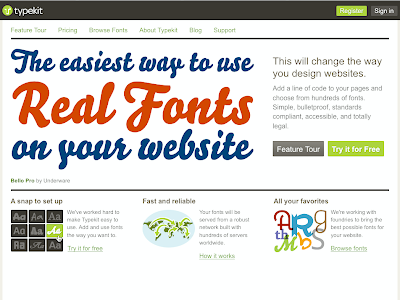
The digital type revolution is an ongoing process begun in the late 1960s with the invention of the first digital typesetting machines. Characters were generated from mathematical formulas and displayed on a screen; the fonts were stored digitally on magnetic disk drives.
In the early 1980s, Adobe Systems developed PostScript, a device-independent output language. In 1985, Apple Computer licensed PostScript for its first LaserWriter 300dpi desktop printer. In that same year, Aldus introduced PageMaker, the first page layout application, and Adobe introduced PostScript Type 1 fonts. The era of desktop typesetting had arrived.

Previous to Type 1, fonts on desktop computers were fixed-sized bitmaps. A font suitcase would include multiple sizes of the same font (e.g., 10pt, 12pt, 18pt), and the user was limited to those sizes. Type 1 fonts are vector-based outlines, making them infinitely scalable (theoretically). Designers were quick to adopt Type 1 as the preferred type format.
In the late 1980s, Apple and Microsoft developed the TrueType format to compete with Type 1. TrueType fonts include more points for hinting* than Type 1 fonts, so they often render better on screen. This makes them the preferred format for system fonts.
In the 1990s Adobe and Microsoft developed the OpenType font format to address some of the shortcomings of the Type 1 and TrueType formats. In addition to the benefit being cross-platform, OpenType’s Unicode encoding allows for 65,000 characters in a single font (compared to 256 characters for a Type 1 font).
These developments in digital type had a profound impact on the design industry. Designers became their own typesetters, and the typesetting industry largely disappeared. Designers had much more typographic control than previously, but at the same time the tools of the designer were now widely available. Anyone with the tools, but not necessarily the skills, of a designer could produce work that previously had been in the domain of trained graphic designers. Designers as never before found themselves in the position of needing to educate clients and the public about good design, its purpose and it’s value.

Through the early 1990s, the primary focus of graphic design remained the printed piece, and the advancements made in digital type served this focus. This began to change with the introduction of the World Wide Web. For the first time, designers were creating designs whose final form was to be viewed on screen. Designers, used to having a great deal of control over their type, found this was not the case when designing for the web. Web pages had to be viewable across platforms and with various browsers. Designers found they had to limit themselves to using fonts which were likely to be loaded on the viewers computer—namely system fonts such as Arial and Times, and later Verdana and Georgia. To get around this, designers often created images of type and placed the images into their web page designs. This allowed for more typographical control, but at a cost. Inserting type as images increases the size of a website, and thus the bandwidth required to download it; it also can make sites inaccessible to people with disabilities.
Today, we are entering the next phase in the digital type revolution, when %ldquo;real fonts” are becoming available on the web. Though CSS has allowed for website font embedding via
@font-face for a number of years, it has been slow to be put into use. There hasn’t been a standard format for web-embedded fonts supported by all of the major browsers, and there has been fear of piracy among type foundries. These concerns are now being addressed. The Web Open Font Format (WOFF) is beginning to be widely embraced, and new type delivery services, such as
Typekit, are helping to address issues of hosting and licensing.
The digital type revolution got off to a slow start, but its impact once desktop typesetting was made possible was dramatic. The rise of the web created new opportunities and frustrations for designers, particularly in the area of typography. Today, digital type is poised to undergo another major shift, bringing fine typography to the web. Designers are keen to see how this current phase of the digital type revolution unfolds, and they are curious to discover what new developments will appear on the horizon.
*“At its most basic level
hinting (or, more accurately,
instructing) a font is a method of defining exactly which pixels are turned on in order to create the best possible character bitmap shape at small sizes and low resolutions.”
http://www.microsoft.com/typography/TrueTypeHintingWhat.mspxIllustrations
Linotype CRTronic 360, one of the first digital typesetting machines.
http://en.wikipedia.org/wiki/File:Linotype_CRTronic_360.jpgBitmap vs. Outline font.
http://www.designhistory.org/Digital_Revolution.htmlWebsite. Home page for the RCI Sound Systems website designed by the author in 1998. A frightening example of a webpage using images for type. Not to mention many nested tables.
Bibliography
Brown, Tim. “Real Web Type in Real Web Context,” A List Apart, November 17, 2009,
http://www.alistapart.com/articles/real-web-type-in-real-web-context/Felici, James.
The Complete Manual of Typography. Berkley: Adobe Press, 2003, 3–19.
Lie, Hakon Wium. “CSS @ Ten: The Next Big Thing,” A List Apart, August 28, 2007,
http://www.alistapart.com/articles/cssattenLupton, Ellen. “Typography on the Web: Questions for Jeffrey Zeldman,” Print Magazine Online.
http://www.printmag.com/Article/Questions-for-Jeffrey-Zeldman-Part-1 and
http://printmag.com/Article/Questions-for-Jeffrey-Zeldman-Part-2Microsoft. Microsoft Type Website,
http://www.microsoft.com/typography/default.mspxPfiffner, Pamela.
Inside the Publishing Revolution: The Adobe Story. Berkley: Adobe Press, 2002, 23–29.
Santa Maria, Jason. “On Web Typography,” A List Apart, November 17, 2009.
http://www.alistapart.com/articles/on-web-typography/Stock-Allen, Nancy. “The Computer Era,”
http://www.designhistory.org/Digital_Revolution.htmlTam, Keith Chi-hang. “Digital typography: a primer,”
http://keithtam.net/writings.htmlZeldman, Jeffrey and Ethan Marcotte.
Designing with Web Standards, 3rd ed. Berkley: New Riders, 2009, 265–293.
Wikipedia. “Phototypesetting,”
http://en.wikipedia.org/wiki/Phototypesetting
 Rochester Bible
Rochester Bible Claricia Psalter
Claricia Psalter Breviary
Breviary Book on Logic (screen shot of the digital surrogate on Issuu)
Book on Logic (screen shot of the digital surrogate on Issuu)













































